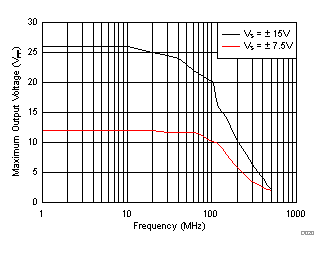SBOS875C August 2017 – February 2023 THS3491
PRODUCTION DATA
- 1 Features
- 2 Applications
- 3 Description
- 4 Revision History
- 5 Device Comparison Table
- 6 Pin Configuration and Functions
- 7 Bare Die Information
- 8 Specifications
- 9 Detailed Description
- 10Application and Implementation
- 11Device and Documentation Support
- 12Mechanical, Packaging, and Orderable Information
Package Options
Mechanical Data (Package|Pins)
Thermal pad, mechanical data (Package|Pins)
Orderable Information
9.4.4 Maximum Recommended Output Voltage
The THS3491 is designed to produce better than 40 dB SFDR while driving a 100-MHz, 20-Vpp signal into a 100-Ω load. To accomplish this, the geometries of certain signal path transistors must be limited. As a result of this limitation, some internal devices begin to saturate when large signal levels are input at frequencies greater than 100 MHz. When these devices saturate, the loop opens and the amplifier is no longer in linear operation. This appears as a gain step-up in the frequency response curve. To avoid this phenomenon, applications must comply with the recommended linear operating region shown in #T4901919-62. #T4901919-62 shows the maximum output voltage vs frequency that is permitted to keep the amplifier in linear operation.
 Figure 9-4 Maximum Recommended Output Voltage vs Frequency
Figure 9-4 Maximum Recommended Output Voltage vs Frequency